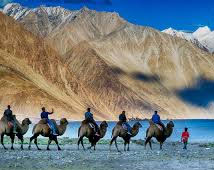
Ladakh is a land like no other. Bounded by two of the world's mightiest mountain ranges, the Great Himalaya and the Karakoram, it lies athwart two other, the Ladakh range and the Zanskar range.
In geological terms, this is a young land, formed only a few million years ago by the buckling and folding of the earth's crust as the Indian sub-continent pushed with irresistible force against the immovable mass of Asia.
Its basic contours, uplifted by these unimaginable tectonic movements, have been modified over the millennia by the opposite process of erosion, sculpted into the form we see today by wind and water.
Yes, water! Today, a high -altitude desert, sheltered from the rain-bearing clouds of the Indian monsoon by the barrier of the Great Himalaya, Ladakh was once covered by an extensive lake system, the vestiges of which still exist on its south -east plateaux of Rupshu and Chushul - in drainage basins with evocative names like Tso-moriri, Tsokar,a nd grandest of all, Pangong-tso. Occasionally, some stray monsoon cluds do find their way over the Himalaya, and lately this seems to be happening with increasing frequency. But the main source of water remains the winter snowfall.
Dras, Zanskar and the Suru Valley on the Himalaya's northern flank receive heavy snow in winter; this feeds the glaciers whose meltwater, carried down by streams, irrigates the fields in summer.
For the rest of the region, the snow on the peaks is virutally the only source of water. As the crops grow, the villagers pray not for rain, but for sun to melt the glaciers and liberate their water. Usually their prayers are answered, for the skies are clear and the sun shines for over 300 days in the year.
Ladakh lies at altitudes ranging from about 9,000 feet (2750m) at Kargil to 25,170 feet (7,672m) at Saser Kangri in the Karakoram. Thus summer temperatures rarely exceed about 27 degree celcuis in the shade, while in winter they may plummet to minus 20 degree celcuis even in Leh.
Surprisingly, though, the thin air makes the heat ofthe sun even more intense than at lower altitudes; it is said that only in Ladakh can a man sitting in the sun with his feet in the shade suffer from sunstroke and frostbite at the same time!

Zanskar Valley
One of Ladakh’s remotest regions. A 300 km long valley ringed by mountains, only accessible by high passes. The Valley of Zanskar is situated in the inner Himalaya and is higher than most areas of Ladakh. The climate is very Harsh and receives very little rain fall. The twin peaks of Nun-Kun, its Monasteries and its extremely rugged, awe-aspiring landscape are its main attractions.
Shyok Valley
The Shyok River receives the waters of the Nubra and Changchenmo rivers. It rises from the Khumdang glacier, which can be approached from Shyok. The Shyok River takes a southerly course after it is joined by the Nubra River. Thereafter the Shyok flows into the Indus at Keris. The river freezes in winter, thus forming an easy access between the Khaplu and the Nubra valleys. In summer, as the snow melts in the uplands, the river overflows its banks and inundates the surrounding plain for many kilometers, at times creating a vast marsh. During this period, the Shyok River has to be crossed on rafts of inflated skin.
Padum Valley
Padum the capital of the ancient kingdom of Zanskar, Padum (3505 m) is the present day administrative headquarters of the region. With a population of nearly 1500, Padum can be described as the most populous settlement of Zanskar, otherwise a very scarcely inhabited valley. Incidentally, it is only in Padum that there is a community of Muslims constituting nearly half the township's population, its origin in the area dating from mid 17th century. Lately, Padum has become a famous as a major trekking base and a popular tourist destination. Several places of tourist interest in the vicinity of the township can be visited in the course of entertaining walks.

Zangla Valley
Lying deep in the northern arm of Zanskar at the end of the 35 km. Long rough road from Padum, Zangla was being ruled by a titular king till his death a few years back. The old castle now in ruins except from a small chappel, occupies a hill, overlooking the desertic valley below. Nearby is the old Nunnery worth a visit for the austere life style of the small monastic community of nuns. An old monastery situated in the nearby village of Tsa-zar has exquisite frescos that should be missed.
Road Distances
Srinagar-Leh 434 Km
Manali-Leh 473 Km
Srinagar-Kargil 204 Km
Delhi-Leh 1047 Kms
Leh-Kargil 234 Km
Kargil-Padum (Zanskar) 240 Km
Leh-Deskit (Nubra Valley) 118 Kms.
Air Travel
Indian Airlines operates regular flights to Leh from Delhi, Four flights in a week from Jammu and once in a week from Chandigarh and twice from Srinagar. Jet Airways also operates daily flights between Leh-Delhi.